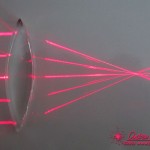Another exhibit built for public outreach functions. It was completed and used for the recent W. M. Keck Observatory open house. You will also be able to see it at the upcoming AstroDay fun in Hilo.
Ray-tracing is a standard way to analyze optical designs. The technique allows the optical designer to follow the path of each ray of light through a system of lenses and mirrors. While ray tracing used to be done with pencil and paper, it is now done on a computer screen. What I had never seen was this process done in the physical. But I can figure out how…

In the photo you can see the idea… Five red laser line modules are aligned across a table. Stick a lens section in the beams and you can observe refraction as it happens. Using a double convex lens, all of the beams converge to a focus. A clear demonstration of the basic principles of optics!

